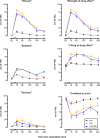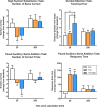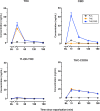Cannabidiol (CBD) content in vaporized cannabis does not prevent tetrahydrocannabinol (THC)-induced impairment of driving and cognition
- PMID: 31044290
- PMCID: PMC6695367
- DOI: 10.1007/s00213-019-05246-8
Cannabidiol (CBD) content in vaporized cannabis does not prevent tetrahydrocannabinol (THC)-induced impairment of driving and cognition
Abstract
Background: The main psychoactive component of cannabis, delta-9-tetrahydrocannabinol (THC), can impair driving performance. Cannabidiol (CBD), a non-intoxicating cannabis component, is thought to mitigate certain adverse effects of THC. It is possible then that cannabis containing equivalent CBD and THC will differentially affect driving and cognition relative to THC-dominant cannabis.
Aims: The present study investigated and compared the effects of THC-dominant and THC/CBD equivalent cannabis on simulated driving and cognitive performance.
Methods: In a randomized, double-blind, within-subjects crossover design, healthy volunteers (n = 14) with a history of light cannabis use attended three outpatient experimental test sessions in which simulated driving and cognitive performance were assessed at two timepoints (20-60 min and 200-240 min) following vaporization of 125 mg THC-dominant (11% THC; < 1% CBD), THC/CBD equivalent (11% THC, 11% CBD), or placebo (< 1% THC/CBD) cannabis.
Results/outcomes: Both active cannabis types increased lane weaving during a car-following task but had little effect on other driving performance measures. Active cannabis types impaired performance on the Digit Symbol Substitution Task (DSST), Divided Attention Task (DAT) and Paced Auditory Serial Addition Task (PASAT) with impairment on the latter two tasks worse with THC/CBD equivalent cannabis. Subjective drug effects (e.g., "stoned") and confidence in driving ability did not vary with CBD content. Peak plasma THC concentrations were higher following THC/CBD equivalent cannabis relative to THC-dominant cannabis, suggesting a possible pharmacokinetic interaction.
Conclusions/interpretation: Cannabis containing equivalent concentrations of CBD and THC appears no less impairing than THC-dominant cannabis, and in some circumstances, CBD may actually exacerbate THC-induced impairment.
Keywords: CBD; Cannabidiol; Cannabis; Cognition; Driving; THC; Tetrahydrocannabinol.
Conflict of interest statement
Nicholas Lintzeris has received funding for sponsored research studies from Camurus and has provided consultancies for Indivior and Mundipharma for unrelated work. Ryan Vandrey has received consulting fees from Zynerba Pharmaceuticals, Battelle Memorial Institute, and Canopy Health Innovations Inc. and has received compensation for being on the advisory boards for Insys Therapeutics, Brain Solutions Inc., and The Realm of Caring Foundation. Paul Haber has received research funding from Camurus, and has provided consultancies for Indivior, Abbvie, and Gilead for unrelated work. Iain McGregor acts as a consultant to Kinoxis Therapeutics and is an inventor on several patents relating to novel cannabinoid therapeutics. The other authors have no conflicts of interest to disclose.
Figures




References
-
- Borgwardt SJ, Allen P, Bhattacharyya S et al (2008) Neural basis of Δ-9-tetrahydrocannabinol and cannabidiol: effects during response inhibition. Biol Psychiatry 64:966–973 - PubMed
-
- Bosker WM, Kuypers KP, Theunissen EL, et al. Medicinal Δ9-tetrahydrocannabinol (dronabinol) impairs on-the-road driving performance of occasional and heavy cannabis users but is not detected in standard field sobriety tests. Addiction. 2012;107:1837–1844. doi: 10.1111/j.1360-0443.2012.03928.x. - DOI - PubMed
Publication types
MeSH terms
Substances
Grants and funding
LinkOut - more resources
Full Text Sources
Medical

